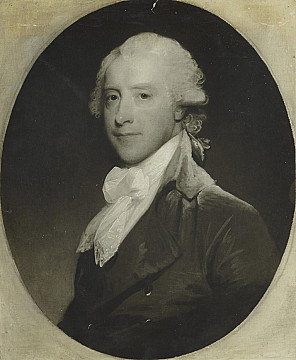William Kerin Constable (1751-1803)
William Kerin Constable, Merchant & Landowner, of New York

Father
He was born in Dublin. His father, a Surgeon with the British Army, lived at Montreal before settling at Schenectady, New York. William graduated from Trinity College, Dublin, before returning to New York and joining his brother-in-law, James Phyn, in the West Indian Trade. He returned to England in 1773 but because of the Revolution was unable to return to America until 1777. In Philadelphia, he swore an oath of allegiance to America and after the war came to New York. In 1784, he founded Constable, Rucke & Co., outfitting the first American vessel to trade with China and India. They also owned the 600-ton America, "one of the finest ships built in New York" and in partnership with Gouverneur Morris and their silent partner (Constable's brother-in-law William Edgar) they were among the first American merchants to trade on a large scale with China while also winning a contract to supply British troops in the West Indies.
He was the principal owner of the 'Macomb Purchase' of 3.6-million acres, making him the largest owner of wild lands in the State of New York - much of which he sold on for a considerable profit. He also owned 500,000-acres in Ohio, Kentucky, Virginia and Georgia. He founded the Northern Inland Lock Navigation Company that made it possible for 10-ton boats to pass from Schenectady to Lake Ontario - the forerunner of the Lake Erie Canal. He was an aide to the Marquis de Lafayette, an honorary member of the Society of the Cincinnati, and President of the St. Patrick's Society at New York. In 1782, he married Anna, daughter of Townsend White of Philadelphia, and they left seven children. His marriage immediately placed him among the highest echelons of society as his wife was a close childhood friend of Martha, the future 1st First Lady of the United States.
He was an intimate friend of Lafayette, Washington, Alexander Hamilton, and John Jay. Ogden Edwards, considered him to be, "the most eloquent man in conversation I ever heard... I first saw him in 1796, at a dinner party. Among the distinguished persons present were General Hamilton, Colonel Burr and Volney. Yet, even in such good company, all eyes and ears were turned to him, and he appeared to be the master spirit".
In New York, Constable first lived in Brooklyn and then Pearl Street. Having secured his fortune, he moved again, living in "splendid style" at a townhouse on Broadway and his country estate at Bloomingdale (roughly where Yankee Stadium stands today), which he sold afterwards to his close friend, John McVickar. For a period, the Constables lived in Europe when they rented their townhouse to Edward Livingston and his sister, Janet, widow of General Richard Montgomery. After Constable died, his widow sold their townhouse to John Jacob Astor, on which he later built the Astor House Hotel. Their son, William, built Constable Hall which remained in their family until 1948.
He was the principal owner of the 'Macomb Purchase' of 3.6-million acres, making him the largest owner of wild lands in the State of New York - much of which he sold on for a considerable profit. He also owned 500,000-acres in Ohio, Kentucky, Virginia and Georgia. He founded the Northern Inland Lock Navigation Company that made it possible for 10-ton boats to pass from Schenectady to Lake Ontario - the forerunner of the Lake Erie Canal. He was an aide to the Marquis de Lafayette, an honorary member of the Society of the Cincinnati, and President of the St. Patrick's Society at New York. In 1782, he married Anna, daughter of Townsend White of Philadelphia, and they left seven children. His marriage immediately placed him among the highest echelons of society as his wife was a close childhood friend of Martha, the future 1st First Lady of the United States.
He was an intimate friend of Lafayette, Washington, Alexander Hamilton, and John Jay. Ogden Edwards, considered him to be, "the most eloquent man in conversation I ever heard... I first saw him in 1796, at a dinner party. Among the distinguished persons present were General Hamilton, Colonel Burr and Volney. Yet, even in such good company, all eyes and ears were turned to him, and he appeared to be the master spirit".
In New York, Constable first lived in Brooklyn and then Pearl Street. Having secured his fortune, he moved again, living in "splendid style" at a townhouse on Broadway and his country estate at Bloomingdale (roughly where Yankee Stadium stands today), which he sold afterwards to his close friend, John McVickar. For a period, the Constables lived in Europe when they rented their townhouse to Edward Livingston and his sister, Janet, widow of General Richard Montgomery. After Constable died, his widow sold their townhouse to John Jacob Astor, on which he later built the Astor House Hotel. Their son, William, built Constable Hall which remained in their family until 1948.
Categories
Share
Contributed by Mark Meredith on 26/07/2021 and last updated on 29/01/2024.
Image Courtesy of the Frick Art Reference Library; American Paintings in The Metropolitan Museum of Art. Vol. 1, 1994

